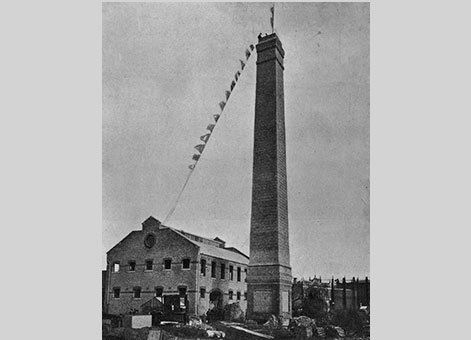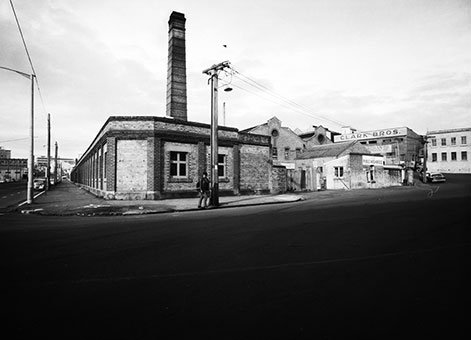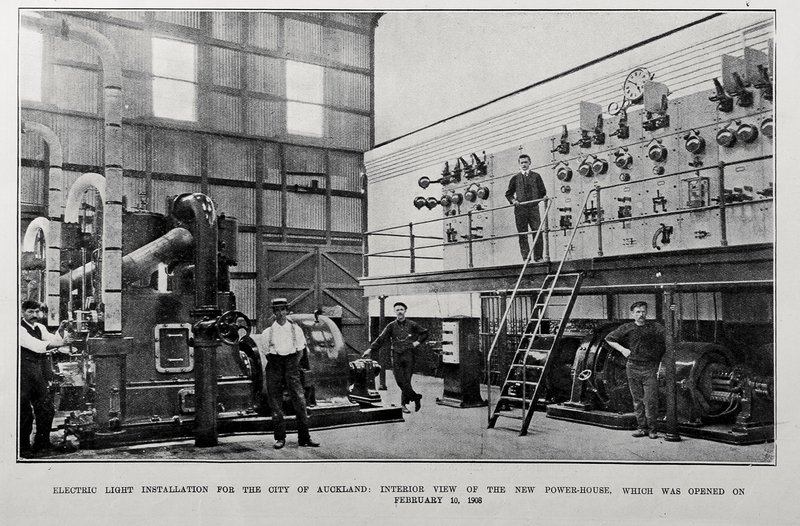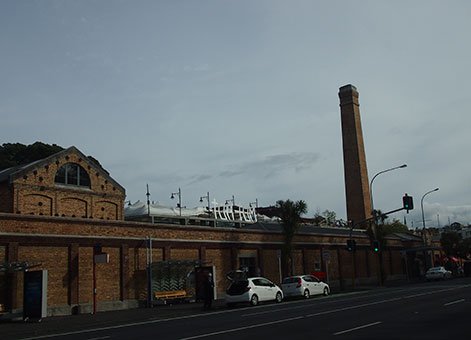The site of Auckland’s Victoria Park Market was once the central refuse collection area for the city, as well as the city works depot.
Disposal of refuse was a serious concern in late-19th century Auckland. In the 1870s collection was contracted out and dumping occurred out of sight and smell. However, in the 1880s citizens had to dispose of their own rubbish. Vacant land became convenient informal tips and rat problems developed. There were real fears of a bubonic plague outbreak in 1900 after some cases were reported in Sydney.

Completing the new refuse destructor, 2 June 1905. Sir George Grey Special Collections, Auckland Libraries, 7-A12013.
These public health concerns caused the Council to consider a municipal refuse destruction plant. In 1904 a tender of £16,840 was accepted from J Barre Johnston Limited of Sydney for the construction of a Meldrum destructor to incinerate the collected refuse. This was completed in 1905.
The polychromatic brick complex included the Council’s works depot, blacksmith’s and carpenter’s shops, stables and a 38 metre high furnace chimney. Alfred Wrigg, City Engineer in 1899–1906, supervised construction.
Soon another feature of the complex was added – electricity supply fuelled by burning rubbish. As Auckland grew, so did the requirement for electricity. In 1906 an Australian engineer, WTG Goodman, reported on the feasibility of using the destructor to generate electricity.

City destructor, 11 July 1968. Sir George Grey Special Collections, Auckland Libraries, 7-A13539.
Goldman’s proposals were accepted, although he criticised the Council for failing to incorporate a generating plant in the original design when initial reports had promoted this idea. Turnbull and Jones won the contract for £11,808. However, the cost subsequently escalated with revisions in potential demand and the provision of additional boilers and new feeders.

Interior view of the powerhouse. Auckland Libraries Heritage Collections AWNS-19080213-12-03
Supply from the complex began in 1908. Within four months demand exceeded supply, so coal was used as a supplementary fuel to the burning rubbish. The generation plant was replaced in 1913 by the Kings Wharf coal-fired station, again built by the Council.

Auckland's former municipal works depot and chimney, May 2015. Engineering New Zealand.
The refuse disposal capacity of the destructor was increased during the 1920s and 1930s. However, by 1960 it was disposing of a mere 10 percent of the city’s rubbish because controlled landfill was preferred. The plant was closed in 1972 although the complex continued to act as a rubbish collection depot until 1981.
Subsequently the former destructor and depot complex’s buildings, including the landmark chimney, were converted into the Victoria Park Market.
Heritage recognition
This place has been recognised by Heritage New Zealand as a Category 1 historic place (List no.7664): Auckland Municipal Destructor and Depot (Former): New Zealand Heritage List/Rarangi Korero information.
More information
Access
The Victoria Park Market is a retail centre open 7 days a week. Their website has specific location and access details.
Source
Bryan Bartley and Elizabeth Aitken Rose, ‘Auckland City Destructor,’ in John La Roche (ed.), Evolving Auckland: The city’s engineering heritage, Christchurch, Wily Publications, 2011, pp.234-36.
Reference
G. W. A. Bush, Decently and In Order: The centennial history of Auckland City Council, Auckland, Collins, 1971.
Location
The block between Victoria Street West, Union and Drake Streets, Auckland city.



